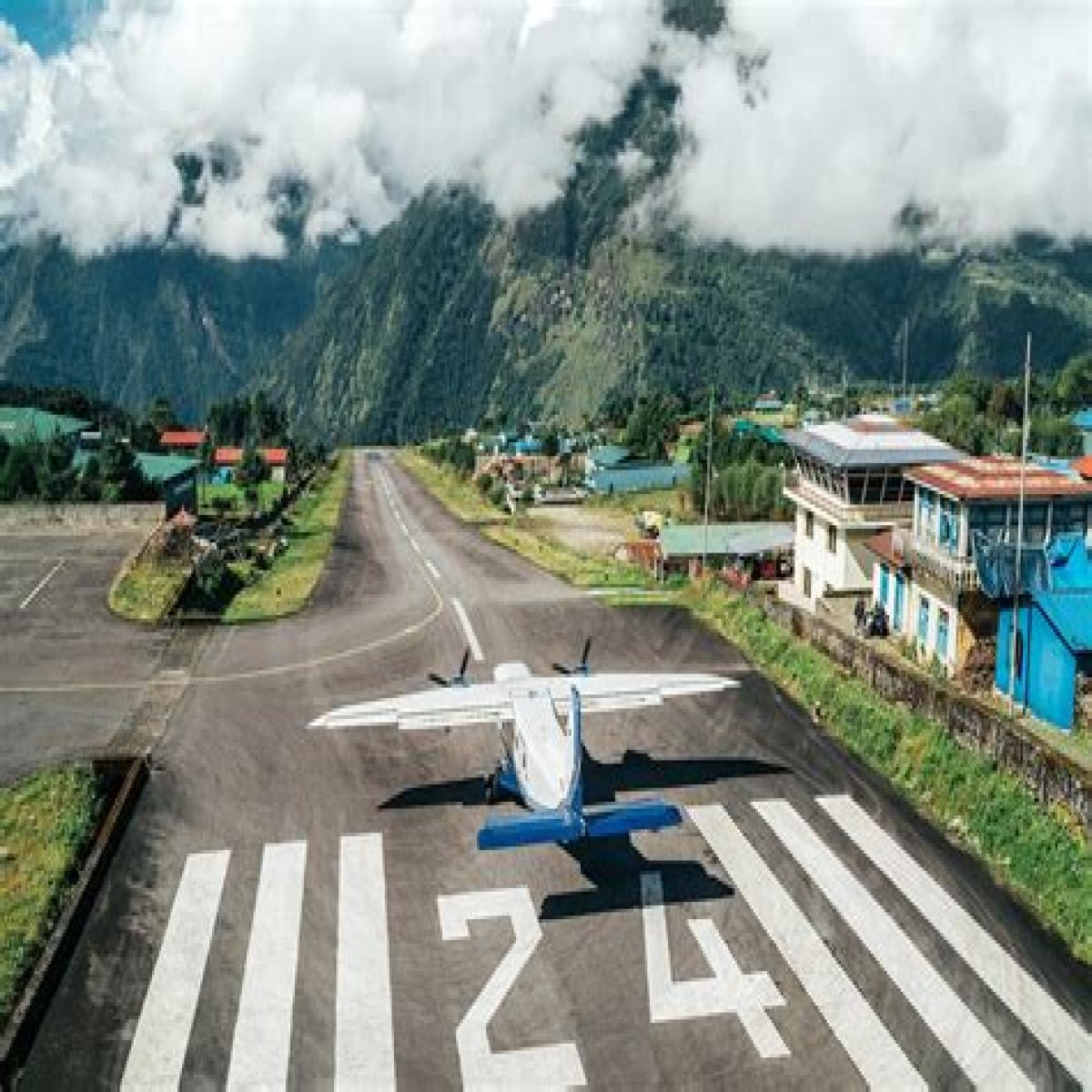News: When thinking of airports, the typical image involves busy terminals, expansive runways, and seamless landings. Yet, there exist a select few airports worldwide that defy these conventional notions, delivering a thrilling experience for both pilots and passengers. These airports go beyond the ordinary, pushing the limits of danger and excitement, demanding unparalleled skill and precision during takeoff and landing. Join us as we explore the heart-pounding realm of the planet’s most perilous airports.
- Lukla Airport (LUA), Nepal
- Courchevel Airport (CVF), France
- Toncontin International Airport (TGU), Honduras
- Congonhas Airport (CGH), Brazil
- Barra International Airport (BRR), Scotland
- Agatti Aerodrome (AGX), India
- Kai Tak Airport, Hong Kong
- Don Mueang International Airport (DMK), Thailand
- Princess Juliana International Airport (SXM), Saint Martin
- Wellington International Airport (WLG), New Zealand
- FAQs
Lukla Airport (LUA), Nepal
Nestled within the formidable peaks of the Himalayas, Lukla Airport stands as the entry point to Mount Everest. Pilots are tasked with maneuvering through a brief, uphill runway that offers little margin for error. Alongside the demanding terrain, they contend with capricious weather patterns and high-altitude conditions, turning each flight into a remarkable display of skill and precision.
Courchevel Airport (CVF), France
Situated amidst the picturesque French Alps, Courchevel Airport is renowned for its exceptionally short runway. Pilots are required to demonstrate exceptional skills as they navigate the steep incline and bring the aircraft to a secure stop. The stunning views of the surrounding mountains add an extra layer of excitement to the overall experience.
Toncontin International Airport (TGU), Honduras
Toncontin International Airport in Tegucigalpa, Honduras, has gained notoriety for its formidable approach. Pilots face the daunting task of navigating through a narrow valley hemmed in by steep mountains, contending with robust crosswinds and abrupt downdrafts. The airport’s reputation as one of the world’s most demanding is attributed to the limited margin for error that pilots encounter during their challenging landings.
Congonhas Airport (CGH), Brazil
Catering to the vibrant city of Sao Paulo, Congonhas Airport is positioned within an urban area, resulting in comparatively short runways. Pilots are required to carry out precise takeoffs and landings to guarantee the safety of passengers and the well-being of the surrounding community.
Barra International Airport (BRR), Scotland
Barra International Airport elevates the notion of distinctive runways to unprecedented heights. Positioned on the beach, the airport’s runways are subject to tides and are only accessible during low tide. Pilots are tasked with precisely timing their landings and departures, thereby demonstrating their expertise in managing these unconventional and dynamic conditions.
Agatti Aerodrome (AGX), India
Nestled in the scenic Lakshadweep archipelago, Agatti Aerodrome presents a formidable challenge for pilots, characterized by its compact runway and the encircling coral reefs. Operating within minimal room for error, pilots are compelled to execute a precise landing to guarantee the safety of both passengers and the aircraft.
Kai Tak Airport, Hong Kong
While no longer in operation, Kai Tak Airport in Hong Kong remains legendary in aviation history. Its notorious approach demanded pilots to navigate through a densely populated urban area, rendering it one of the most formidable airports for landing. Today, the airport stands as a testament to the skill and expertise required to successfully tackle such challenging conditions.
Don Mueang International Airport (DMK), Thailand
Situated in Bangkok, Don Mueang International Airport presents a distinctive challenge for pilots with its intersecting runways. Maintaining vigilance and heightened awareness of aircraft movements is crucial for pilots to ensure safe operations and prevent potential accidents at this airport.
Princess Juliana International Airport (SXM), Saint Martin
Princess Juliana International Airport is celebrated for its close adjacency to Maho Beach, drawing tourists who gather to witness planes flying mere feet above their heads. Pilots face the challenge of a steep approach over the beach and contend with strong crosswinds, delivering an exhilarating experience for both passengers and onlookers alike.
Wellington International Airport (WLG), New Zealand
Wellington International Airport is recognized for its demanding wind conditions, requiring pilots to adeptly navigate strong crosswinds, introducing notable challenges during landings and takeoffs. The unpredictable nature of these winds adds an extra layer of excitement to the overall aviation experience.
The top 10 most perilous airports showcase a requirement for a level of skill, precision, and courage that surpasses conventional standards. These airports serve as a testament to the resilience and expertise of pilots and aviation professionals who adeptly navigate treacherous terrains, contend with unpredictable weather, and conquer challenging landscapes. Despite the inherent risks, these airports stand as enduring symbols of human ingenuity and the unwavering determination to master the skies against formidable odds.
As technology progresses and safety measures evolve, the thrill of flight remains interwoven with the stark reality of navigating some of the world’s most challenging environments. The narratives behind each airport unfold like captivating tales of human ingenuity pitted against the formidable forces of nature. So, fasten your seatbelts and join us on this exhilarating journey as we delve into the heart-pounding world of aviation’s most audacious landscapes.
FAQs
1. What contributes to the peril of an airport?
An airport may be deemed hazardous based on factors like challenging terrain, unpredictable weather conditions, short runways, nearby obstacles, or complicated approaches.
2. Are passengers safe at airports deemed dangerous?
Even though airports with challenging characteristics necessitate skilled pilots and precision, they are designed with passenger safety in mind. Stringent safety protocols and regulations are implemented at such airports to minimize risks and ensure secure operations.
3. Is it possible for anyone to travel to these hazardous airports?
Indeed, anyone can fly to these dangerous airports by booking a flight with an airline that serves those routes. Nevertheless, it is recommended to be well-prepared for the distinctive challenges and risks associated with these specific airport locations.
